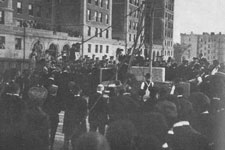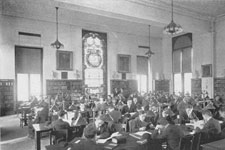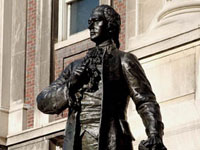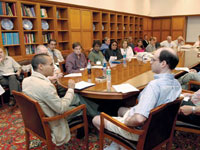COVER STORY
Hamilton 100
College Celebrates Centennial of Renewed Flagship Building
By Shira Boss-Bicak 93, 97J, 98 SIPA
Illustrations By Elisha Cooper
Hamilton Hall, the physical heart of Columbia College, this fall celebrates its 100th anniversary and the completion of a renovation that restores and improves upon its original glory.
“When Hamilton Hall was built in 1907,” says Dean Austin Quigley, “the ambitious goal was to provide a splendid home of the College.’ Here, in a building named for its most famous alumnus and trustee, the College would base its faculty, teach its students and locate its administrative offices. The importance of a flagship building for the College was as evident then as it is today, to symbolize the College’s aspirations, to provide a central site for its history and its traditions and to provide the continuity that always is essential in a world of change.”
The cornerstone for Hamilton Hall was laid on September 27, 1905, and construction was completed two years later, the McKim, Mead & White building being the first on the Morningside Heights campus dedicated to the undergraduate college. It still houses the Office of the Dean and the Office of Undergraduate Admissions, as well as four department offices Germanic Languages, Slavic Languages, Classics, and Italian Languages plus the Center for Race and Ethnicity, faculty offices and 37 classrooms ranging from intimate seminar rooms to large lecture halls. An expansive Center for the Core Curriculum was opened in May 2004, when the building was rededicated. The lobby also was refurbished and features the restoration of two grand, vintage Tiffany stained-glass windows that were originally part of the midtown campus.


Hamilton Halls cornerstone is laid on September 27, 1905. This photo appeared in
the 1907 Columbian.

The lofty College Study on the main floor of Hamilton Hall was closed when another floor was added to expand the building.
Photos: Columbia University Archives-Columbiana Library

“The renovation of Hamilton Hall is significant as a renewal of physical space and as a symbolic milestone,” says Nicholas Dirks, v.p. of arts and sciences. “The College always has been the centerpiece of the arts and sciences at Columbia University, and Hamilton Hall represents the commitment of our faculty to providing the very best undergraduate education.”
The building and its mission will be celebrated at a Hamilton 100 cake and champagne reception on Saturday, September 8, at which The Columbia Campaign for Undergraduate Education will be officially launched. Ronald Chernow, author of the biography Alexander Hamilton, will take part in the celebration along with top College and University officials.
The original Hamilton Hall, named for Alexander Hamilton (Class of 1778), co-author of the Federalist Papers and the country’s first secretary of the treasury, opened in 1880 as part of the campus on Madison Avenue at 49th Street. The campus was relocated to Morningside Heights in 1897 and South Field, the area below 116th Street including the land on which Hamilton now stands, was acquired in October 1903.
When Hamilton Hall opened in 1907, Dean John Howard Van Amringe (Class of 1860) declared, “This is a great day for the College. Now, for the first time since Columbia was installed on these heights, our alma mater has a home of her own a building more stately and beautiful, as of right it ought to be, more gracious and significant than any other on the grounds of the University.”
The Core Curriculum, the centerpiece of a College education, was founded in Hamilton Hall in 1919. Among the may famous teachers who have taught, and in some cases studied, in Hamilton classrooms are Jacques Barzun ’27, Wm. Theodore de Bary ’41, John Erskine (Class of 1900), Moses Hadas, Dwight Miner ’26, Lionel Trilling ’25 and Mark Van Doren.
The building also has been the center of several student protests, including an occupation in April 1968 when it was the first of five buildings taken over by students in protest of planned construction of a gym in Morningside Park as well as the Vietnam War. In 1987, black students chained themselves to the Hamilton entrance to protest a brawl outside Ferris Booth Hall involving black and white students. The building was blockaded by students in 1992 to protest the University’s plans to develop the site of the Audubon Ballroom, where Malcolm X was assassinated in 1965, and again in 1996 to protest the College’s not having an ethnic studies department (the Center for the Study of Ethnicity and Race, now offering three undergraduate majors, opened in 1999).


Photo: Eileen Barroso

Alumni Reunion Weekend 2007 attendees enjoy a lecture in the beautiful new Core Conference Room.
Photo: David Wentworth

Hamilton’s first total renovation was started in January 2000 by R.M. Kliment & Frances Halsband Architects, with a budget of $25 million. Approximately 60 percent of the funding for the renovations came from donations from alumni and parents.
“The renovation of Hamilton Hall was a wonderful opportunity to join two centuries of creative thinking into one important campus landmark,” says Frances Halsband, the project’s lead architect. “Bringing back the vision of Nicholas Murray Butler [Class of 1882] and McKim, Mead & White meant restoring the lobby, finding and restoring the stained-glass windows and reconstructing offices as they might have been. Both centuries influenced the design of the seminar rooms, with their restored oak paneling and state-of-the-art media capacity.”
The renovation included a new Center for the Core Curriculum, housed to the right of the entrance in what previously was the Admissions Office. The center is home to the Literature Humanities, Contemporary Civilization, Music Humanities, Art Humanities and Major Cultures departments and includes a historical archive with text from the Core courses.
“It’s only proper that the Center for the Core Curriculum, which my wife and I proudly support, rests in majestic Hamilton Hall,” says Richard Witten ’75, vice-chair of the University Board of Trustees and chairman emeritus of the College Board of Visitors, whose generous gift funded the Core Center. “Tens of thousands of our College graduates know just how important their Core experiences have been to their success, and clearly associate those experiences with the newly-renovated Hamilton Hall, the physical center of Columbia College.”
Providing a Center for the Core Curriculum helps integrate its various elements, “developing the Core as a set of related courses rather than juxtaposed courses,” Quigley says. “In these new quarters, the Center for the Core functions not just as an administrative unit but also as a historical archive, a teacher training unit and a research and publication center for Core-related materials.”
Hamilton Hall’s infrastructure was restored and upgraded, including extensive work on HVAC, lighting and technology that now allows wireless access throughout. The Office of the Dean was renovated, thanks to the support of Michael Bruno ’43.
The Admissions Office was moved to a renovated and expanded suite on the left side of the lobby. A new, glass pavilion entrance to the Admissions Office directly from College Walk was added.
When Quigley went searching for artifacts to use in the restoration, he discovered in University storage two large Tiffany stained-glass windows that dated to the 19th century. The windows, portraits of Sophocles and Vergil, originally were installed in the midtown campus and then in a lounge in Hartley residence hall before being crated and stored in the 1950s.
When Quigley and Derek Wittner ’65, dean of alumni affairs and development, invited A.G. Rosen ’65, an art history major, to see the windows in storage beneath the Business School, Rosen was not sure what to expect. “When they were opened up, I thought, Holy mackerel, these are really good!’” he says. “I hadn’t realized how wonderful they were. I’m very proud to be involved and very humbled they asked me to fund the restoration.” The windows originally were a gift of the Classes of 1885 and 1891.
The windows were cleaned and restored by Martin Rambusch ’93 Arch. at his restoration company in Jersey City and installed at opposite ends of Hamilton’s renovated lobby, which now feature display cases showing the evolution of the Core, with a timeline, early syllabi and textbooks, fulfilling Quigley’s goal of creating “a display area for the history of the College and the Core.”
Renovation and upgrading of the building’s classrooms began in 2000 and continued through this past summer. Classrooms have been improved acoustically and wiring has been upgraded. Wood paneling encases the lower walls and windows and also frames the slate blackboards. Modern lighting is dimmable and motion-sensitive to conserve electricity. The College thanks the many alumni and parents whose support made this renovation possible.
The result is a Hamilton Hall that fulfills Quigley’s vision of a renovated building that “will serve in part to sustain the best of the original building, in part to recover some of its earlier splendor and in part to renew the resources it can provide for the changed world in which it now functions. Preservation, renovation and renewal provide the vital signs of a thriving college, never content with yesterday’s achievements nor forgetful enough of them to be dominated by the truisms of today or the trendiness or tomorrow.”
Shira Boss-Bicak ’93, ’97J, ’98 SIPA is a CCT staff writer and the author of Green with Envy: A Whole New Way to Look at Financial (Un)Happiness.
|

